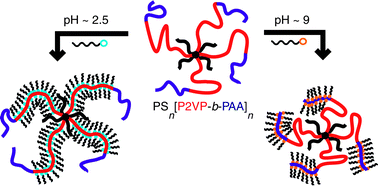A novel heteroarm star block terpolymer bearing short polystyrene (PS) arms and an equal number of longer poly(2-vinylpyridine)-block-poly(acrylic acid) (P2VP-b-PAA) arms was used as the macromolecular template component in polyelectrolyte-surfactant supramolecular complexes. The ampholytic nature of this novel star block copolymer allowed complexation to be carried out on either the P2VP blocks (with negatively charged surfactants) or on the PAA blocks (with positively charged surfactants), depending only on the pH at which the complexation reaction was carried out. The various complexes displayed self-organization on both the length scale of the polyelectrolyte-surfactant complexes (ca. 3.5–4 nm) and on the length scale of the overall heteroarm star block copolymer (18–39 nm, depending on which block had been complexed). Addition of surfactants to one block versus the other results in dramatically different morphologies; when the P2VP blocks are complexed, close-packed spheres are observed, while when the PAA blocks are complexed, the material forms core-shell cylinders (PS and P2VP composing the core and shell, respectively) in a matrix of PAA(surfactant). The morphologies are discussed by combining both real-space techniques, such as transmission electron miscroscopy, and reciprocal space techniques, such as X-ray scattering at small and large angles.

You have access to this article
 Please wait while we load your content...
Something went wrong. Try again?
Please wait while we load your content...
Something went wrong. Try again?


 Please wait while we load your content...
Please wait while we load your content...